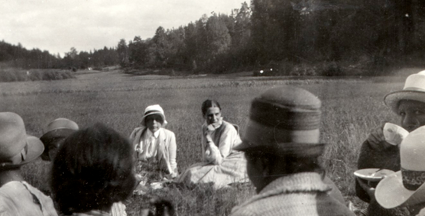Åsa Elzén
June 2, 2012
Opening: Mary Wollstonecraft’s Scandinavian journey 1795 re-traced at Kalmar Konstmuseum, 2/6 – 2/9 2012

Forest Calling – A Never-ending Contaminated Collaboration or Dancing is a Form of Forest Knowledge
Public art commission in collaboration with Malin Arnell within the framework of Local Art Projects funded by Statens Konstråd / Public Art Agency Sweden (2019 –)
Through Forest Calling – A Never-ending Contaminated Collaboration or Dancing is a Form of Forest Knowledge the possibilities of ensuring legal protection of a forest (approx. 4 hectares) belonging to Fogelstad, Julita are investigated. A prejudicial legal document is formulated, that together with a number of choreographed intra–actions draw up the guidelines for what it may imply "to practice a mutually sustainable relating", as well as securing the forest's agency and viability in an infinite future. The connection to Fogelstad is of importance for the project, since the queer feminist Fogelstad group, who among other things ran the Women Citizen’s School at Fogelstad (1925-54) was strongly involved in the "land issue” (jordfrågan) which today can be interpreted as being part of a further discussion about ecology and resilience. By making the forest a public artwork, it is lifted out of its predetermined context and becomes a kind of resistance to the Western teleological concept of time. The forest continues to live in another temporality, where a time axis from the Fogelstad group is allowed to proceed instead of being broken through clear-cutting. Thus, the forest writes itself into a specific assemblage of symbioses, histories, temporalities and relationships with other life forms, but also with human movements.

September 7, 2019, noon
Opening: Part of the Labyrinth, GIBCA 10th edition, Gothenburg, 7/9–17/11
curator: Lisa Rosendahl
I am participating with:
Transcript of a Fallow / Avskrift av en Träda
Appliqué, recycled textile, 470 x 600 cm, 2019
Transcript of the carpet En Träda (“A Fallow”), tapestry, wool, linen, 470 x 600 cm, 1919–1920, by Elisabeth Tamm at Fogelstad who conceived the idea and commissioned, by Maja Fjaestad who conceptualized and composed, by Amelie Fjaestad who weaved.
To leave land fallow means to allow it to lie uncultivated in order to regain its fertility. The piece is a continuation of Elzén’s long-term work with the legacy of the queer feminist initiative the Fogelstad Group formed in Sweden in 1921. Elzén’s work is a transcript of a carpet titled, En Träda (“A Fallow”) made by Maja and Amelie Fjaestad in 1919–20, that lay in the library at the farm and education centre Fogelstad. The use of the term transcript, rather than copy, proposes a historiographical process interwoven with the present: by reworking the original, a contemporary reading of the piece becomes a visible part and continuation of its history. While the original carpet was woven of linen and wool from Fogelstad, Elzén’s version is made of recycled fabrics from a variety of different sources, materials, and years of manufacture. Visitors may tread the carpet without their shoes. More info to come!

Transcript of a Fallow / Avskrift av en Träda at the opening of GIBCA 2019 at Röda Sten Konsthall, Gothenburg
Oct 13 2019, 14-15.30
Discussion: Remixing Thoughts: Re-Learning the Pause
GIBCA, Röda Sten Konsthall, Gothenburg
Pella Thiel, an ecology and nature rights activist and Stina Bäckström,
a philosopher, talk about recovery from an ecological and a psychological perspective. Language: Swedish. Starting from my work Transcript of a Fallow, the conversation takes place on the carpet/fallow and will be moderated by me.
Oct 23 2019, 18-19.30
Artist Talk Åsa Elzén, GIBCA, Röda Sten, Gothenburg (on the carpet/fallow)
Nov 26 2019, 18-19.30
Fallow: Seminar with Åsa Elzén
Tensta Konsthall, Stockholm
I will share my long-term work on the Fogelstad group with emphasis on my current engagement in its ecofeminist legacy and how artists and artistic processes are interwoven in this historiography. We will gather on the carpet Transcript of a Fallow (2019) a textile transcript of the carpet A Fallow (1919) that was placed in the library at Fogelstad back in the day. Language: English. The Seminar is part of "Practicing Politics: The Fogelstad Women's Citizenship School 1925–1954" by Olivia Plender, curator Hannah Zafiropoulos
Nov 30 2019, 14-17.00
talk / opening: Conversationon a Fallow – On the Fogelstad group, Earth and Forest, Kolonin, Arvika
Åsa Elzén in conversation with Cecilia Bengtson, organic farmer, moderated by OTALT. The talk takes place on Transcript of a Fallow that is brought to the space for the day. Language: Swedish. Åsa’s exhibition in Kolonin‘s window gallery is open until Jan 18 2020
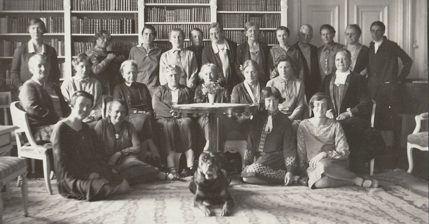
Elisabeth Tamm and Honorine Hermelin facing the camera with a group of participants from the Women Citizen’s School at Fogelstad, date and photographer unknown. Part of Åsa Elzén’s project Transcript of a Fallow and still from Why do things when you could leave it?— An attempt, an in-between land, video, 28 min, Åsa Elzén, 2019
Participants in the Women Citizen’s School at Fogelstad and Pojken (The Boy)
on the carpet “A Fallow” in the library at Fogelstad
print of photograph by Axel Fredriksson (1894–1971), taken at Fogelstad during the 1920s and ’30s. Selected, title, scanned, and adapted by Åsa Elzén with permission from The Nordic Museum Archive, each print 34,3 x 30 cm, Åsa Elzén, 2019

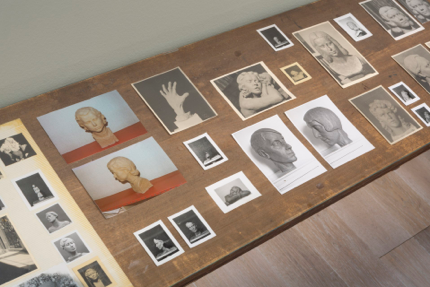
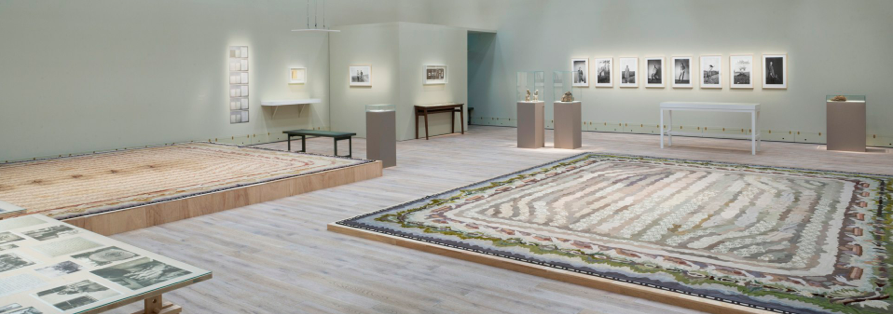

May 30, 2020
Opening: Träda – Fogelstadgruppen och jord / Notes on a Fallow –
Sörmlands museum, Nyköping, 30/5 2020 – 26/1 2021
curator: Joanna Nordin
This solo-exhibition is a continuation of Åsa Elzén’s long-term work on the Fogelstad group, a queer feminist initiative formed in Sweden in 1921. In an expanding and interdisciplinary project, where boundaries between historical materials and new works are fluid, the artist explores the group’s practice in ecology and resilience, bringing forth the role of artists and artistic processes in expanding this history.
Press release (SWE / ENG) and more photos
...
above: Installation view Sörmlands museum, right A Fallow, Maja Fjaestad 1919-20, left: Transcript of a Fallow, Åsa Elzén 2019
right: A growing archive about the Women’s Barn and Livestock School at Fogelstad /
Ett växande arkiv över Kvinnliga Ladugårdsutbildningen vid Fogelstad, 2020- (detail)
Photographs by Maren Holebakk of her sculptures of students at the Barn and Livestock School in unburnt clay from the fields at Fogelstad, approx 1930 –40s, placed on a school desk from the Women Citizen’s School at Fogelstad,

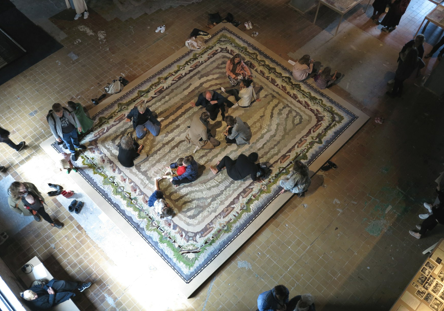



Oct 9, 2021. 13.00
Opening: Träda – Fogelstadgruppen och jord / Notes on a Fallow –
Rackstadmuseet, Arvika, 9/10 2021 – 9/1 2022
curator: Joanna Nordin and Hannes Trygg
This large solo-exhibition is a continuation of Åsa Elzén’s long-term work on the Fogelstad group, a queer feminist initiative formed in Sweden in 1921. In an expanding and interdisciplinary project, where boundaries between historical materials and new works are fluid, the artist explores the group’s practice in ecology and resilience, bringing forth the role of artists and artistic processes in expanding this history.
Artist Maja Fjaestad was part of the Rackstad group and her large carpet A Fallow was vowen in Rackstad 1919 in the Fjaestad sisters’ weavery. Now it is coming back for a visit after 101 years spent at Fogelstad, where it lay in the librabry until the end of the 1960’s and later in the attic, after being worn down by the Fogelstad queer feminist community (and their dogs).
...
above: water color sketch in preparation for the carpet A Fallow / En Träda, Maja Fjaestad, 1919
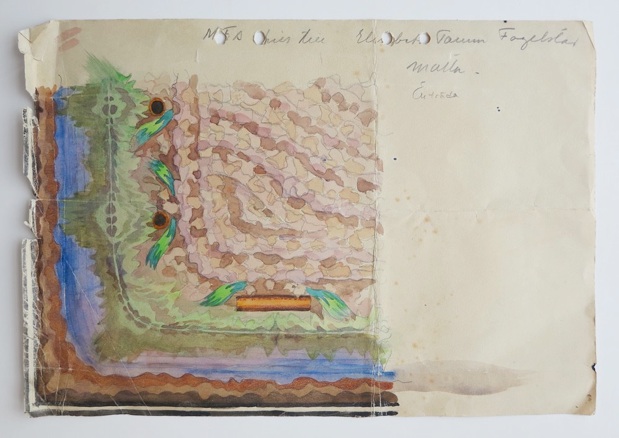
Mars 10, 2021
Opening: Experimentalfältet, Accelerator, SU, Stockholm 10/3–19/9 2021
curated by Therese Kellner and Richard Julin
Malin Arnell and I are participating with:
I am also participating with
Why do things when you could leave it? – An attempt, an in-between land
Participating artists: Andrea Zittel, Signe Johannessen, O in collaboration with The non existent Center, Uglycute, Kultivator
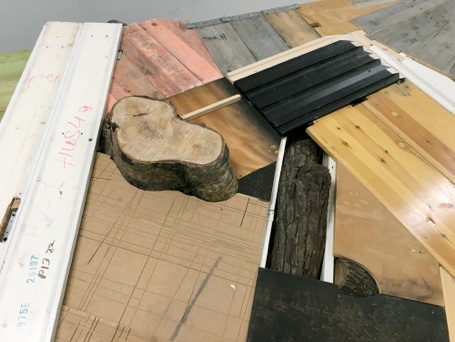
Sep 10 2020, 8:45–19.00
In Forest Intervals / Responding to the Forest’s Call
Forest Intervals / Responding to the Forest’s Call is a full-day public programme with Forest Calling. Join us on a bus ride from Stockholm to a specific piece of forest – a public artwork. Along the way, we make a visit to Notes on a Fallow – The Fogelstad group and earth at Sörmlands museum.
Contributors: The Association Forest Calling: Malin Arnell and Åsa Elzén (SWE); Maria Thereza Alves (BRA); Katarina Bonnevier (SWE); Åsa Elzén (SWE); Becoming-Sensor: Natasha Myers, Ayelen Liberona and Allison Cameron (CAN); Merete Røstad (NOR); Pella Thiel (SWE).
Produced by Statens konstråd / Public Art Agency Sweden, in collaboration with Sörmlands museum, Åsa Elzén and Malin Arnell
Sep 9, 2021 8:45
In collaboration with Malin Arnell, within Experimentalfältet, Accelerator
A full-day program focusing on the rights of nature, peace with the earth and a specific forest’s local situation and history.
Contributors: Malin Arnell & Åsa Elzén, Pia Björstrand, Ola Engelmark, Anna Karin Hammar, MYCKET, Kulturföreningen Fogelstad


